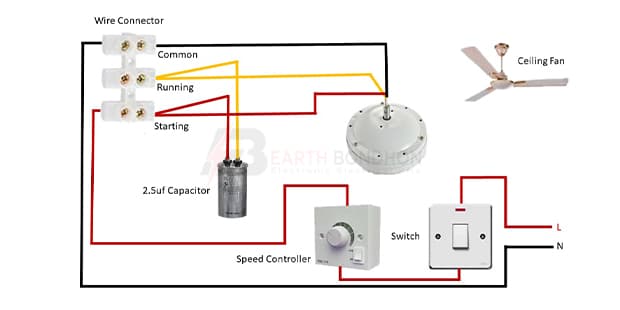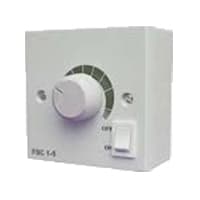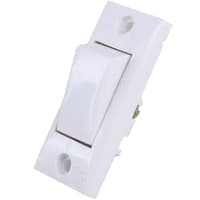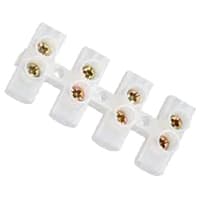Fan Regulator Connection:
This diagram shows how to make a fan regulator connection. In this circuit diagram, we use a ceiling fan, a wire connector, a fan capacitor, a fan speed control regulator, and a switch. First, we need to input power to the switch, then from the switch input connection to the fan regulator, then from the fan regulator to connect with the fan capacitor and fan. After the complete all connection it’s now ready for use. If you want to know more about this circuit please check our youtube video at the below link.
Advertisements
Components needed For this Project:
You can get the components from any of the sites below:
- Ceiling Fan 56-Inch [See Buy Click Amazon]
- 2.5 MFD Capacitor (220V ac Line) [See Buy Click Amazon]
- Fan Regulator [See Buy Click Amazon]
- Gang Switch [See Buy Click Amazon]
- Terminal Block [See Buy Click Amazon]
*Please note: These are affiliate links. I may make a commission if you buy the components through these links. I would appreciate your support in this way!
Advertisements
Components used to make the Fan Regulator Connection:
A Ceiling Fan is a fan Mounted on the Ceiling of a Room or space, Usually, Electrically Powered, That Uses hub-mounted Rotating Blades to Circulate air flow. They cool people effectively by increasing speed. It Doesn not Cool the Air Temperature — we Feel Cooler Because the Fan Moves the Air Around Us, a Process Called Evaporative Cooling. Evaporative Cooling Works like this: A cold day will feel Even Cooler if There is a Breeze Because of the wind Chill Factor.
02. 2.5uf Capacitor:
Motor Starting Capacitors are used during the Motor Startup Phase and are Disconnected From the Circuit once the Rotor Reaches a Predetermined Speed, Which is Usually about 75% of the Maximum Speed for that Motor type. These Capacitor Usually Have Capacitance Values Of Over 70 UF. The Starting capacitor creates a Current-to-Voltage lag in the Separate start Windings of the Motor. Starting Capacitor are Wired into The Auxiliary Winding Circuit of the Motor and are Disconnected from the main winding circuit by the Centrifugal Switch once the Motor has Reached a Predetermined Speed.
A Fan Speed Controller Controls The Voltage Across the Fan and Therefore Indirectly Controls its speed 220v AC line. A ceiling Fan Speed Regulator Actually Measures and Regulates the Speed of the Fan Using its Tachometer. Fan Speed is Controlled with Thyristor or Transformer Speed Controllers for Ceiling fans, and table fans. the fan is Controlled by a Capacitor, and the Voltage across the fan Determines the fan speed. A Speed Control loop Can be Implemented That is Independent of Manufacturing Variances and Wear on The Fan control system.
04. Switch:
An SPST (Single Pole Single Throw) Switch is a Switch That only Has a Single Input and can Connect Only to one Output. This means it Only Has one Input Terminal and Only 1 Output Terminal. A Switch is a Mechanical or Controlling Device That Changes the Flow of Current Direction or Interrupts the Flow of Current Within a Circuit diagram. An electrical line using Single Pole Single Throws (SPST) is Perfect for on-off switching. When the SPST is closed, the Circuit is Closed and the light from the lamp switches on the system. When The Single Pole Single Throw (SPST) is then opened, the light from the lamp goes out and the Circuit is off.
Terminal Clocks are Connectors That Terminate a Single wire and Connect it to a circuit or other system. Terminal Blocks come in a range of shapes, Sizes, and ratings, but Always Terminate a single Wire and are Never multi-pole. Terminal Blocks are used to Secure or Terminate Wires and, in Their Simplest form, Consist of Several Individual Terminals Arranged in a long strip system. Terminals are Useful for Connecting the Wiring to the GND or, in the Case of Electrical power, for Connecting Electrical Switches and Outlets to the Mains side.
Thank You for visiting the website. Keep visiting for more Updates.
Frequently asked questions
A fan regulator increases the speed of a fan by controlling the amount of electrical power supplied to the fan motor. This is typically achieved using a variable resistor or electronic circuitry diagram to adjust the voltage or current and flowing to the motor.
It could be due to faulty wiring and connection, a defective of regulator unit, the power supply, or an issue with the fan motor itself. It's also possible that there is an electrical issue causing fluctuations in the regulator's output.
In the power supply TRIAC-based electronic fan regulator circuit diagram, the main components used are a resistor, capacitor, DIAC, and TRIAC. TRIAC is directly used to control the speed by holding and releasing the current and flow.
The speed of the fan decreases with the Circuit Diagram increase in the number Digite of turns connected in the inductance coil winding. Heat and power supply loss are low in these regulators. The disadvantages are low power supply factor, cost, weight, and bulkiness.
In this circuit, A Diac is connected with the gate terminal of the triac. One side of the Variable resistor is connected to the Triac terminal through a 22k resistor and another side of VR connected to a capacitor is connected with Diac.
Read more Single Phase Wiring
What is a kilowatt-hour (kWh) | kwh formula | What does kwh mean
Introduction to Electrical Units and CircuitskW and kWh on your electricity bill As your home uses electricity during...
What is the Difference Between kVA | What does KVA mean | kVA formula
Difference Between KVA ExplainedWhat does KVA Mean? There are technical terms aplenty when it comes to generators, and...
Power Factor | Power Unit | Energy | Electricity Unit
Power factor definition | Calculating Power FactorPower Factor Values In a purely resistive circuit, the power factor...






0 Comments
Trackbacks/Pingbacks